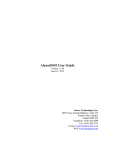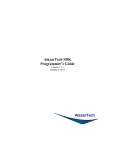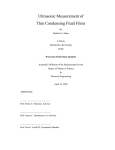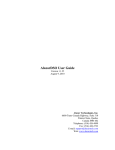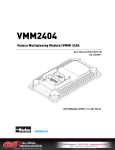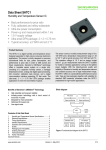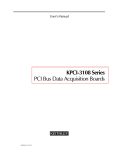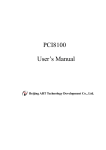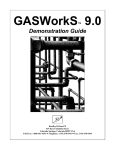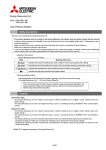Download ATS850 User Manual
Transcript
ATS850 User Manual 8 Bit, 50 MS/s Waveform Digitizer for PCI Bus Written for Hardware Version 1.3 November 2008 Edition Part Number: 850-USR-6 Copyright © 2003-2008 AlazarTech. All rights reserved. AlazarTech Contact Information AlazarTech, Inc. 6600 Trans-Canada Highway, Suite 310 Pointe-Claire, Quebec Canada H9R 4S2 Telephone: (514) 426-4899 Fax: (514) 426-2723 E-mail: [email protected] Web site: www.alazartech.com To comment on the documentation for ATS850, send e-mail to [email protected]. Information required when contacting AlazarTech for technical support: Owned by: ___________________________ Serial Number: ___________________________ Purchase Date: ___________________________ Purchased From: ___________________________ Software Driver Version: ___________________________ SDK Version: ___________________________ AlazarDSO™ Version: ___________________________ Operating System: ___________________________ ATS850 User Manual i Important Information Warranty The ATS850 is warranted against defects in materials and workmanship for a period of one year from the date of shipment, as evidenced by receipts or other documentation. AlazarTech, Inc. will, at its option, repair or replace equipment that proves to be defective during the warranty period. This warranty includes parts and labor. The media on which you receive AlazarTech, Inc. software are warranted not to fail to execute programming instructions, due to defects in materials and workmanship, for a period of 90 days from date of shipment, as evidenced by receipts or other documentation. AlazarTech, Inc. will, at its option, repair or replace software media that do not execute programming instructions if AlazarTech, Inc. receives notice of such defects during the warranty period. AlazarTech, Inc. does not warrant that the operation of the software shall be uninterrupted or error free. A Return Material Authorization (RMA) number must be obtained from the factory and clearly marked on the outside of the package before any equipment will be accepted for warranty work. AlazarTech, Inc. will pay the shipping costs of returning to the owner parts that are covered by warranty. AlazarTech, Inc. believes that the information in this document is accurate. The document has been carefully reviewed for technical accuracy. In the event that technical or typographical errors exist, AlazarTech, Inc. reserves the right to make changes to subsequent editions of this document without prior notice to holders of this edition. AlazarTech, Inc. may also make improvements and/or changes in the products and/or programs described in this document at any time. The reader should consult AlazarTech, Inc. if errors are suspected. In no event shall AlazarTech, Inc. be liable for any damages arising out of or related to this document or the information contained in it. The latest user manual can be found on the AlazarTech, Inc. web page at www.alazartech.com/support/downloads.htm. EXCEPT AS SPECIFIED HEREIN, ALAZARTECH, INC. MAKES NO WARRANTIES, EXPRESS OR IMPLIED, AND SPECIFICALLY DISCLAIMS ANY WARRANTY OF MERCHANTABILITY OR FITNESS FOR A PARTICULAR PURPOSE. CUSTOMER’S RIGHT TO RECOVER DAMAGES CAUSED BY FAULT OR NEGLIGENCE ON THE PART OF ALAZARTECH, INC. SHALL BE LIMITED TO THE AMOUNT THERETOFORE PAID BY THE CUSTOMER. ALAZARTECH, INC. WILL NOT BE LIABLE FOR DAMAGES RESULTING FROM LOSS OF DATA, PROFITS, USE OF PRODUCTS, OR INCIDENTAL OR CONSEQUENTIAL DAMAGES, EVEN IF ADVISED OF THE POSSIBILITY THEREOF. This limitation of the liability of AlazarTech, Inc. will apply regardless of the form of action, whether in contract or tort, including negligence. Any action against AlazarTech, Inc. must be brought within one year after the cause of action accrues. AlazarTech, Inc. shall not be liable for any delay in performance due to causes beyond its reasonable control. The warranty provided herein does not cover damages, defects, malfunctions, or service failures caused by owner’s failure to follow the AlazarTech, Inc. installation, operation, or maintenance instructions; owner’s modification of the product; owner’s abuse, misuse, or negligent acts; and power failure or surges, fire, flood, accident, actions of third parties, or other events outside reasonable control. Copyright Under the copyright laws, this publication may not be reproduced or transmitted in any form, electronic or mechanical, including photocopying, recording, storing in an information retrieval system, or translating, in whole or in part, without the prior written consent of AlazarTech, Inc. Trademarks AlazarTech, Inc.™, AlazarTech™, alazartech.com™, ATS™, ATS850™, AlazarDSO™, are trademarks of AlazarTech, Inc. Product and company names mentioned herein are trademarks or trade names of their respective companies. ii ATS850 User Manual Warning Regarding Use of AlazarTech Products 1. ALAZARTECH, INC. PRODUCTS ARE NOT DESIGNED WITH COMPONENTS AND TESTING FOR A LEVEL OF RELIABILITY SUITABLE FOR USE IN OR IN CONNECTION WITH SURGICAL IMPLANTS OR AS CRITICAL COMPONENTS IN ANY LIFE SUPPORT SYSTEMS WHOSE FAILURE TO PERFORM CAN REASONABLY BE EXPECTED TO CAUSE SIGNIFICANT INJURY TO A HUMAN. 2. IN ANY APPLICATION, INCLUDING THE ABOVE, RELIABILITY OF OPERATION OF THE SOFTWARE PRODUCTS CAN BE IMPAIRED BY ADVERSE FACTORS, INCLUDING BUT NOT LIMITED TO FLUCTUATIONS IN ELECTRICAL POWER SUPPLY, COMPUTER HARDWARE MALFUNCTIONS, COMPUTER OPERATING SYSTEM SOFTWARE FITNESS, FITNESS OF COMPILERS AND DEVELOPMENT SOFTWARE USED TO DEVELOP AN APPLICATION, INSTALLATION ERRORS, SOFTWARE AND HARDWARE COMPATIBILITY PROBLEMS, MALFUNCTIONS OR FAILURES OF ELECTRONIC MONITORING OR CONTROL DEVICES, TRANSIENT FAILURES OF ELECTRONIC SYSTEMS (HARDWARE AND/OR SOFTWARE), UNANTICIPATED USES OR MISUSES, OR ERRORS ON THE PART OF THE USER OR APPLICATIONS DESIGNER (ADVERSE FACTORS SUCH AS THESE ARE HEREAFTER COLLECTIVELY TERMED “SYSTEM FAILURES”). ANY APPLICATION WHERE A SYSTEM FAILURE WOULD CREATE A RISK OF HARM TO PROPERTY OR PERSONS (INCLUDING THE RISK OF BODILY INJURY AND DEATH) SHOULD NOT BE RELIANT SOLELY UPON ONE FORM OF ELECTRONIC SYSTEM DUE TO THE RISK OF SYSTEM FAILURE. TO AVOID DAMAGE, INJURY, OR DEATH, THE USER OR APPLICATION DESIGNER MUST TAKE REASONABLY PRUDENT STEPS TO PROTECT AGAINST SYSTEM FAILURES, INCLUDING BUT NOT LIMITED TO BACK-UP OR SHUT DOWN MECHANISMS. BECAUSE EACH END-USER SYSTEM IS CUSTOMIZED AND DIFFERS FROM ALAZARTECH, INC.’s TESTING PLATFORMS AND BECAUSE A USER OR APPLICATION DESIGNER MAY USE ALAZARTECH, INC. PRODUCTS IN COMBINATION WITH OTHER PRODUCTS IN A MANNER NOT EVALUATED OR CONTEMPLATED BY ALAZARTECH, INC., THE USER OR APPLICATION DESIGNER IS ULTIMATELY RESPONSIBLE FOR VERIFYING AND VALIDATING THE SUITABILITY OF ALAZARTECH INC. PRODUCTS WHENEVER ALAZARTECH, INC. PRODUCTS ARE INCORPORATED IN A SYSTEM OR APPLICATION, INCLUDING, WITHOUT LIMITATION, THE APPROPRIATE DESIGN, PROCESS AND SAFETY LEVEL OF SUCH SYSTEM OR APPLICATION. ATS850 User Manual iii Compliance FCC/Canada Radio Frequency Interference Compliance* Determining FCC Class The Federal Communications Commission (FCC) has rules to protect wireless communications from interference. The FCC places digital electronics into two classes. These classes are known as Class A (for use in industrial-commercial locations only) or Class B (for use in residential or commercial locations). Depending on where it is operated, this product could be subject to restrictions in the FCC rules. (In Canada, the Department of communications (DOC), of Industry Canada, regulates wireless interference in much the same way.) Digital electronics emit weak signals during normal operation that can affect radio, television, or other wireless products. By examining the product you purchased, you can determine the FCC Class and therefore which of the two FCC/DOC Warnings apply in the following sections. (Some products may not be labeled at all for FCC; if so, the reader should then assume these are Class A devices.) FCC Class A products only display a simple warning statement of one paragraph in length regarding interference and undesired operation. Most of our products are FCC Class A. The FCC rules have restrictions regarding the locations where FCC Class A products can be operated. FCC Class B products display either a FCC ID code, starting with the letters EXN, or the FCC Class B compliance mark. Consult the FCC web site http://www.fcc.gov for more information. FCC/DOC Warnings This equipment generates and uses radio frequency energy and, if not installed and used in strict accordance with the instructions in this manual and the CE Mark Declaration of Conformity**, may cause interference to radio and television reception. Classification requirements are the same for the Federal Communications Commission (FCC) and the Canadian Department of Communications (DOC). Changes or modifications not expressly approved by AlazarTech Inc. could void the user’s authority to operate the equipment under the FCC Rules. Class A Federal Communications Commission This equipment has been tested and found to comply with the limits for a Class A digital device, pursuant to part 15 of the FCC Rules. These limits are designed to provide reasonable protection against harmful interference when the equipment is operated in a commercial environment. This equipment generates, uses, and can radiate radio frequency energy and, if not installed and used in accordance with the instruction manual, may cause harmful interference to radio communications. Operation of this equipment in a residential area is likely to cause harmful interference in which case the user will be required to correct the interference at his own expense. Canadian Department of Communications This Class A digital apparatus meets all requirements of the Canadian InterferenceCausing Equipment Regulations. Cet appareil numérique de la classe A respecte toutes les exigences du Règlement sur le matériel brouilleur du Canada. iv ATS850 User Manual Compliance to EU Directives Readers in the European Union (EU) must refer to the Manufacturer's Declaration of Conformity (DoC) for information** pertaining to the CE Mark compliance scheme. The Manufacturer includes a DoC for most every hardware product except for those bought for OEMs, if also available from an original manufacturer that also markets in the EU, or where compliance is not required as for electrically benign apparatus or cables. To obtain the DoC for this product, click Declaration of Conformity at http://www.alazartech.com/support/documents.htm. This web page lists all DoCs by product family. Select the appropriate product to download or read the DoC. * Certain exemptions may apply in the USA, see FCC Rules §15.103 Exempted devices, and §15.105(c). Also available in sections of CFR 47. ** The CE Mark Declaration of Conformity will contain important supplementary information and instructions for the user or installer. Environmental Compliance Alazar Technologies Inc., hereby certifies that this product is RoHS compliant, as defined by Directive 2002/95/EC of the European Parliament and of the Council of 27 January 2003 on the restriction of the use of certain hazardous substances in electrical and electronic equipment. All manufacturing has been done using RoHS-compliant components and lead-free soldering. ATS850 User Manual v Table of Contents CHAPTER 1 - INTRODUCTION ..................................................1 About Your ATS850 .....................................................................2 Acquiring Data with Your ATS850................................................3 Interactively Controlling your ATS850 with AlazarDSO™........4 ATS-SDK API ...........................................................................5 ATS-VI LabVIEW VI..................................................................5 ATS-Linux .................................................................................6 Optional Upgrades .......................................................................7 CHAPTER 2 - INSTALLATION AND CONFIGURATION...........8 What You Need to Get Started ....................................................9 Unpacking ..................................................................................11 Installing the ATS850 .................................................................12 Installing the ATS850 in a Linux System....................................26 Compiling the ATS850 Linux Driver ...........................................27 Configuring Internet Security and Virus Protection Software to Allow Proper Operation of ATS Class Digitizers ........................28 Updating ATS850 Driver ............................................................30 CHAPTER 3 - HARDWARE OVERVIEW..................................32 Input Connectors ........................................................................33 Signal Connections ....................................................................34 Analog Input ...............................................................................35 Pipelined ADC ........................................................................36 Pre-Trigger Multiple Record Acquisition.................................36 Specifying Record Length ......................................................36 Specifying Pretrigger Depth....................................................37 Specifying Record Count........................................................37 Calibration ..................................................................................38 Master/Slave Operation..............................................................39 Restrictions .............................................................................40 Optional Trigger Out Upgrade....................................................42 APPENDIX A - SPECIFICATIONS............................................44 vi ATS850 User Manual Chapter 1 - Introduction This chapter describes the ATS850 and lists additional equipment. ATS850 User Manual 1 About Your ATS850 Thank you for your purchase of an ATS850. The ATS850 PCI based waveform digitizer has the following features: • Two 8-bit resolution analog input channels • Half length PCI bus card • Real-time sampling rate of 50 MS/s to 10 KS/s • 25 MHz analog input bandwidth • Analog trigger channel with software-selectable level, slope, and hysteresis • Software-selectable AC/DC coupling and 1MΩ/50Ω input impedance • 262,140 sample onboard memory, standard • Pre-trigger and Post-Trigger Capture with Multiple Record capability • NIST traceable calibration • Optional Trigger Out Upgrade for Ultrasonic Applications All ATS850 digitizers follow industry-standard Plug and Play specifications on all platforms and offer seamless integration with compliant systems. If your application requires more than two channels for data acquisition, you can synchronize multiple digitizers on all platforms using a Master/Slave SyncBoard. Detailed specifications of the ATS850 digitizers are listed in Appendix A, Specifications. 2 ATS850 User Manual Acquiring Data with Your ATS850 You can acquire data either programmatically by writing an application for your ATS850 or interactively with the AlazarDSO™ software. If you want to integrate the ATS850 in your test and measurement or embedded OEM application, you can program the digitizer using C/C++, Visual BASIC or LabVIEW. For programming in C/C++ or Visual BASIC, you must purchase the ATS-SDK software development kit that comes with sample programs and a reference manual describing the API. For programming in LabVIEW, you must purchase the ATSVI virtual instrument library that comes with a high-level, easy-to-use VI that makes integrating the ATS850 into your own system very simple. ATS850 User Manual 3 Interactively Controlling your ATS850 with AlazarDSO™ The AlazarDSO™ Soft Front Panel allows you to interactively control your ATS850 as you would a desktop oscilloscope. To launch the Scope Soft Front Panel, select Start » Programs » AlazarTech » AlazarDSO™ The following screen will be displayed. If you connect the input to a signal generator and click on Start button, you should see the signal on the screen. AlazarDSO™ has been designed to be very intuitive and uses the same user interface as most of today’s digital oscilloscopes. • 4 Note that AlazarDSO™ does not support Windows 98. If you are using Windows 98SE, you can use the legacy API Panel software for acquiring signals interactively. ATS850 User Manual ATS-SDK API The ATS-SDK API is used for programming the ATS850 in C/C++ or Visual BASIC. It provides the exact same API that is used for writing AlazarDSO™ software. To help you get started, ATS-SDK comes with examples you can use or modify. ATS-VI LabVIEW VI ATS-VI allows you to integrate the ATS850 into your own LabVIEW program. A high level VI is supplied that requires very few controls to get started. ATS850 User Manual 5 ATS-Linux ATS-Linux allows you to integrate the ATS850 into a Linux application written in C. Linux drivers are provided as source code. Note that a Non Disclosure Agreement must be executed between AlazarTech and the end customer for this source code to be released. All sample programs are supplied in C source code. Drivers are compatible with kernel versions up to and including 2.6 and are tested with Fedora Core 5. 6 ATS850 User Manual Optional Upgrades AlazarTech offers the following upgrades and accessories for use with your ATS850 digitizer: • ATS850: External Clock Upgrade • ATS850: Master/Slave SyncBoard 2 position • ATS850: Master/Slave SyncBoard 4 position • ATS850: Master/Slave SyncBoard 8 position • ATS850: Trigger Out Upgrade ATS850 User Manual 7 Chapter 2 - Installation and Configuration This chapter describes how to unpack, install, and configure your ATS850. 8 ATS850 User Manual What You Need to Get Started To set up and use your ATS850, you will need the following: • One or more ATS850 digitizers • ATS850 Install Disk • For Master/Slave operation only: SyncBoard of appropriate width SyncBoard 2X for up to 2 digitizers ATS850 User Manual 9 SyncBoard 4X for up to 4 digitizers SyncBoard 8X for up to 8 digitizers 10 ATS850 User Manual Unpacking Your digitizer is shipped in an antistatic package to prevent electrostatic damage to the digitizer. Electrostatic discharge can damage several components on the digitizer. To avoid such damage in handling the digitizer, take the following precautions: • Ground yourself via a grounding strap or by holding a grounded object. • Touch the antistatic package to a metal part of your computer chassis before removing the digitizer from the package. • Remove the digitizer from the package and inspect the digitizer for loose components or any other sign of damage. Notify AlazarTech if the digitizer appears damaged in any way. Do not install a damaged digitizer into your computer. • Never touch the exposed pins of the connectors. ATS850 User Manual 11 Installing the ATS850 There are four main steps involved in installation: 1. Physically install the digitizer(s) and SyncBoard, if any, in your computer. 2. Install ATS850 software driver 3. Install AlazarDSO™ software that allows you to setup the hardware, acquire signals and view and archive them 4. Optionally, install the ATS-SDK software development kit or ATS-VI LabVIEW VI, which enables you to programmatically control the ATS850 Thanks to the flexible nature of AlazarTech’s driver installation software, you can either install the hardware first or install the software driver first. The following paragraphs will guide you through this process in a step-by-step manner. 12 ATS850 User Manual 1. Physically install the digitizer in your computer Make sure that your computer is powered off before you attempt to insert the ATS850 digitizer in one of the free PCI slots. For best noise performance, leave as much room as possible between your ATS850 and other hardware. Always screw the digitizer bracket to the chassis in order to create a stable and robust connection to chassis ground. In the absence of such a connection, ATS850 is not guaranteed to operate within the specifications listed elsewhere in this manual. ATS850 User Manual 13 For Master/Slave Installation If you are installing multiple ATS850 digitizers that will be configured as a Master/Slave system, make sure that you insert all cards in adjacent slots. The connector on the SyncBoard that is labeled as “M” (Master), must be inserted into the Master/Slave connector of the left-most digitizer, if you are facing the BNC connectors of the ATS850 digitizers. 14 ATS850 User Manual If you are installing fewer than the maximum number of digitizers supported by your SyncBoard, the unused SyncBoard connectors must be on the righthand side of the digitizers, if you are facing the BNC connectors of the ATS850 digitizers. Zoomed in, this should look as shown below: Once you have completed this step, you should power the computer on. ATS850 User Manual 15 2. Install ATS850 software driver The following instructions guide you through the process of installing the ATS850 in a computer running Windows Vista, Windows XP or Windows 2000 operating systems. Other operating systems, such as Windows NT, Windows 95 and Windows 98SE are not covered here. Note that the images of the dialog boxes shown below were taken from a Windows XP computer. Computers running Vista may have slightly different dialog boxes. Installation of Multiple ATS850 Digitizers If you are installing multiple ATS850 digitizers, the operating system will detect one card at a time and you will have to go through the driver installation setup as many times as you have cards. 16 ATS850 User Manual Installing ATS850 Hardware First If you decided to install the ATS850 hardware before installing the ATS850 software driver, then when you first boot up the computer, the plug-n-play Windows operating system will detect the presence of a new PCI card and ask you to provide the device driver. a) When you power on for the first time, Windows will display the Welcome to the Found New Hardware Wizard Click Cancel. ATS850 User Manual 17 b) Insert the installation CD. If it does not auto-run, manually run the Setup.exe program on the ATS850 Driver Disk. Click Next. c) The following dialog box will be displayed showing the progress of installation of ATS850 driver files in the operating system driver store. 18 ATS850 User Manual d) The following final screen will confirm that the driver has been installed. Now your ATS850 is fully installed and is ready to use. ATS850 User Manual 19 Installing ATS850 Driver First If you decided to install the ATS850 software driver before installing the ATS850 hardware, then you must follow the following sequence to make sure your operating system recognizes ATS850 as an installed device. a) Insert the installation CD. If it does not auto-run, manually run the Setup.exe program on the ATS850 Driver Disk. Click Next. 20 ATS850 User Manual b) The following dialog box will be displayed showing the progress of installation of ATS850 driver files in the operating system driver store. c) The following final screen will confirm that the driver has been installed. d) Power down your computer e) Physically install your ATS850 card(s). If you are installing a Master/Slave system, also install the SyncBoard. ATS850 User Manual 21 f) Power on your computer g) Windows will display the Welcome to the Found New Hardware Wizard Click Next h) The following dialog box will be displayed: 22 ATS850 User Manual i) Choose to install the software automatically. Click Next Operating system will copy the appropriate files to its system folders. The following dialog box will be displayed: j) Operating system will display the Completing the Found New Hardware Wizard message. Click Finish. Now your ATS850 is fully installed and is ready to use. ATS850 User Manual 23 3. Install AlazarDSO™ software that allows you to setup the hardware, acquire signals and view and archive them If you are installing from the CD shipped with the ATS850 digitizer: • Insert the ATS850 Install disk • Use Windows Explorer to navigate to the appropriate AlazarDSO™ folder on the ATS850 Install Disk. Run Setup.exe program. • Follow the instructions on the screen. If you are installing AlazarDSO™ after having downloaded the installation file from AlazarTech web site: 24 • Download AlazarDSO™ installation file from www.alazartech.com/support/downloads.htm • Unzip the file downloaded in the previous step. • Browse to the folder that contains the unzipped file, Setup.exe • Run this executable file and follow the instructions on the screen. ATS850 User Manual 4. Optionally, install the ATS-SDK software development kit or ATS-VI LabVIEW VI, which enables you to programmatically control the ATS850 Insert the ATS-SDK or ATS-VI CD. Software installation will start automatically. If, for any reason, installation does not start automatically, run the SETUP.EXE program. Follow the instructions on the screen. Note that you must have already installed the ATS850 drivers for any of the sample programs included with the ATS-SDK or ATS-VI to work properly. ATS850 User Manual 25 Installing the ATS850 in a Linux System ATS850 is fully compatible with the popular Linux operating system. AlazarTech supplies binary Linux drivers that have been compiled for Fedora Core 5 (kernel 2.6). Customers who require drivers for another version of Linux must contact the factory to obtain source code for the drivers (requires a Non-Disclosure Agreement). AlazarTech will not provide software support for compiling drivers for other versions of Linux, i.e. customers will be fully responsible for compiling drivers for their own Linux operating system. To install Linux drivers in a Fedora Core 5 system, follow the instructions listed below: 1. Copy the supplied RPM file to the target machine 2. Double-click on the RPM icon. This will install the driver as well as associated applications. 3. Reboot the PC. Note that if you do not reboot the PC, the driver will not be loaded. The RPM file will also install an application called AlazarDSO™. This is a Graphical User Interface (GUI) using which you can setup and acquire data from the ATS850. Note that AlazarDSO™ has been compiled using GTK 2.4 libraries. If you intend to use an operating system other than Fedora Core 5, make sure that the GTK 2.4 libraries have been installed on your machine. Linux version of AlazarDSO™ does not have all the features of the Windows based AlazarDSO™. 26 ATS850 User Manual Compiling the ATS850 Linux Driver If you need to compile the ATS850 driver for a version of Linux other than Fedora Core 5, follow the following steps: 1. Install the Linux kernel header files. 2. Extract the driver sources using the command "tar xvfz PlxLinux-2006.01.10.tgz". This will create a folder names "PlxLinux" with the driver files inside. 3. Set the shell environment variable PLX_SDK_DIR to the root location where the "PlxLinux" directory was created. For example, if using bash and the PlxLinux directory is in your home directory, then add the following line to the ~/.bashrc : declare -x PLX_SDK_DIR=$HOME/PlxLinux 4. To build the ATS850 driver, type cd PlxLinux/linux/driver ./builddriver 850 This will create the file Pci9054/ATS850.ko, the loadable driver file. You can change build defines in PlxLinux/linux/makefiles/Gcc.def. Copy the driver to /usr/local/AlazarTech/bin. 5. Load the driver by rebooting the computer or typing: cd /usr/local/AlazarTech/bin ATS850.rc start The customer should be able to run the AlazarDSO™ application or Acq2Disk sample in /usr/local/AlazarTech/samples/ATS850. 6. If it is necessary to rebuild the library, type cd PlxLinux/linux/api make This will create SharedLibrary/libPlxApi.so.0.0. Copy the file to /usr/local/AlazarTech/lib and then run ldconf ATS850 User Manual 27 Configuring Internet Security and Virus Protection Software to Allow Proper Operation of ATS Class Digitizers Some of the recent releases of internet security and virus protection software packages, such as Norton Anti-Virus, disable any unused parallel or serial ports as well as any PCI devices that have not been assigned to a software application by the user. Users of AlazarTech PCI digitizers must configure their security software to allow access to the PCI digitizers. The problem exhibits itself as a blue-screen crash and a “STOP Error”. Typically, this error message is: STOP: 0x0000000A (0x00000016, 0x0000001C, 0x00000000, 0x804E5DEB) For more details on this problem with anti-virus software packages, refer to the technical note on Microsoft’s support site : http://support.microsoft.com/kb/892000/EN-US Also refer to the knowledgebase article on Symantec’s web site: http://service1.symantec.com/SUPPORT/sharedtech.nsf/0/26 71ef6e5d72d3cd88256d26006699d5?OpenDocument This article explains that the root of the problem is one of the files updated by the Symantec anti-virus software. Symantec suggests that users should upgrade their internet security software using Live Update, but our customers’ experience has been that this does not always work. 28 ATS850 User Manual The solution that always works is: • Remove Norton Anti-Virus software • Reboot the PC after removing Norton Anti-Virus. • Make sure AlazarTech hardware and software are fully functional • Re-install Norton Anti-Virus software AlazarTech PCI digitizer products are fully compatible with all internet security and anti-virus software. Users must make sure that their security software has been updated and configured properly. ATS850 User Manual 29 Updating ATS850 Driver From time to time, AlazarTech updates the device drivers for its products. These updates may be required for product enhancements or for bug fixes. This section of the manual takes you through the steps required to update the device driver for the ATS850 PCI digitizer. In other words, this section shows you how to install a newer version of the driver, when you already have a previous version of the driver installed on your machine. 1. Download the latest driver from AlazarTech’s web site: www.alazartech.com/support/downloads.htm 2. Unzip the downloaded file to a local folder 3. Run the resulting installation file (*.exe extension). For example, the installation file for driver version 5.6.9 is called ATS850_Driver_V5.6.9.exe. The following welcome screen will be displayed: Click Next. 30 ATS850 User Manual 4. The following dialog box will be displayed showing the progress of installation of ATS850 driver files. 5. The following final screen will confirm that the driver has been installed. 6. Click Finish. ATS850 driver has now been updated. ATS850 User Manual 31 Chapter 3 - Hardware Overview This chapter includes an overview of the ATS850, explains the operation of each functional unit making up your ATS850, and describes the signal connections. Following is a highlevel block diagram of ATS850. CH A Analog Front-End A D C ASoPC CH B Analog Front-End A D C Acquisition System On Programmable EXT Trig Analog Front-End Trigger Circuit Chip (FPGA) EXT Clock Input Protection P C I B U S 32 Memory PCI Bus Interface ASIC ATS850 User Manual Input Connectors These ATS850 digitizers have two standard BNC female connectors for CH A and CH B analog input connections, one standard BNC female connector for the EXT (External Trigger) input and one standard BNC female connector for the optional ECLK (External Clock) input. The following pictorial shows the various connectors available on the digitizer bracket. Identification LED For future use Channel A Channel B External Trigger Optional External Clock input Or Optional TRIG OUT output ATS850 User Manual 33 Signal Connections You can use CH A and CH B to digitize data as well as to trigger an acquisition. Use the EXT input for an external analog trigger only; data on the TRIG channel cannot be digitized. If External Clock Upgrade is installed on your ATS850, use the ECLK input for clocking the ATS850 in applications that require an external clock. Note that the frequency of the signal injected into the ECLK connector must remain between 50 MS/s and 10 KS/s. 34 ATS850 User Manual Analog Input The two analog input channels are referenced to common ground in bipolar mode. These settings are fixed; therefore, neither the reference nor the polarity of input channels can be changed. You cannot use CH A or CH B to make differential measurements or measure floating signals unless you subtract the digital waveforms in software. For accurate measurements, make sure the signal being measured is referenced to the same ground as your ATS850 by attaching the probe’s ground clip to the signal ground. The EXTernal Trigger input has a programmable input range of ±5 V or ±1 V. The CH A, CH B, and EXT inputs have a softwareprogrammable coupling selection between AC and DC. Use AC coupling when your AC signal contains a large DC component. Without AC coupling, it is difficult to view details of the AC component with a large DC offset and a small AC component, such as switching noise on a DC supply. If you enable AC coupling, you remove the large DC offset for the input amplifier and amplify only the AC component. This technique makes effective use of dynamic range to digitize the signal of interest. The low-frequency corner in an AC-coupled circuit is the frequency below which signals are attenuated by at least 3 dB. The low-frequency corner is approximately 10 Hz with 1 MΩ input impedance and 100 KHz with 50Ω input impedance. ATS850 User Manual 35 Pipelined ADC The ADC on the ATS850 is a pipelined flash converter with a maximum conversion rate of 50 MS/s. If you use an external clock, you must provide a free-running clock to ensure reliable operation. You also must follow all the timing specifications on the external clock as described in Appendix A, Specifications. Using a pipelined architecture also introduces a lower limit on the sampling rate. For the ATS850, the accuracy starts to degrade below 10 KS/s. Pre-Trigger Multiple Record Acquisition The ATS850 allows the capture of multiple records into the on-board memory. This allows you to capture rapidly occurring triggers in lightning test, ultrasound or radar applications. Unlike other digitizers on the market, users are allowed to acquire both pre- and post-trigger data when acquiring more than one record in an acquisition session. This feature can be very useful in lightning test, power line monitoring and other applications that feature rapidly occurring transient signals. Specifying Record Length Record Length is specified in number of sample points. It must be a minimum of 64 points and can be specified with a 4-sample resolution up to a maximum of the per-channel onboard memory. Record Length thus specified determines the maximum number of records you can capture in one acquisition session. The relationship is given by: Max. Records = (Per-Channel Memory) / (Record Length + 4) Note that, unlike other products in its class, ATS850 allows you to capture multiple records into the on-board memory without requiring software-assisted re-arming of the digitizer. 36 ATS850 User Manual Specifying Pretrigger Depth ATS850 acquires a certain number of samples, called the pretrigger depth, before it allows the trigger circuitry to operate, thereby guaranteeing that the required number of sample points will be captured before trigger occurs. User is allowed to set pretrigger depth for an acquisition session. Same values are used for all records captured in that session. Pretrigger depth can be a minimum of 0 points and can be specified with a 4 sample resolution up to a maximum of (Record Length –64). Specifying Record Count User can specify the number of records that must be captured in one acquisition session. The minimum value must be 1 and the maximum value is given by: Max. Records = (Per-Channel Memory) / (Record Length + 4) ATS850 User Manual 37 Calibration Calibration is the process of minimizing measurement errors by making small circuit adjustments. All ATS850 digitizers come factory calibrated to the levels indicated in Appendix A, Specifications. Note that AlazarTech calibration is fully NIST traceable. However, your digitizer needs to be periodically recalibrated in order to maintain its specified accuracy. This calibration due date is listed on the CALIBRATION sticker affixed to your ATS850 digitizer. Externally recalibrate the ATS850 when this calibration interval has expired. This requires three very simple steps: 1. Verify whether or not ATS850 is still within its specifications. If it is, then your calibration can be extended by another one-year period 2. If not, perform calibration, i.e. make adjustments to the circuit until it is within specifications again 3. If any adjustments have been made, verify if the ATS850 is within specifications Verification and Calibration procedures are available to all registered users of ATS850 upon request. 38 ATS850 User Manual Master/Slave Operation You can use two or more ATS850 digitizers in one system to increase the number of channels for your application by synchronizing digitizers using the appropriate SyncBoard. Currently, up to 16 channel (8 board) systems are supported for ATS850. For higher channel counts, contact the factory for special system configuration. Unlike other products on the market, ATS850 does not suffer from clock jitter between master and slave digitizers. The unique design of the ATS850 clock circuit provides a buffered copy of the Master digitizer’s clock to itself and all the slave digitizers, thereby maintaining a very low skew between Master and Slave digitizer clocks. Note that an ATS850 Master/Slave system is capable of triggering from any one of its input channels. This is valuable in multi-channel detector applications that cannot predict the input channel that is going to receive the first pulse. With fully synchronous A/D conversion, arming and triggering, an ATS850 based Master/Slave system is an ideal multi-channel transient analyzer. ATS850 User Manual 39 Restrictions To ensure proper master/slave operation of your ATS850 digitizers, you must observe the following restrictions: • All Master/Slave digitizers must be installed in adjacent slots, i.e. there should be no gap between the digitizers that are to be configured as a Master/Slave system Good Installation 40 Bad Installation • You must connect the appropriate SyncBoard to all of the ATS850 digitizers in your system. Note that all SyncBoards are polarized, so you cannot make a mistake in inserting them • If you are using fewer than the maximum number of digitizers allowed by the SyncBoard, make sure that the connector labeled “M” (Master) on the SyncBoard is connected to one of the ATS850 digitizers. Any over-hang of the SyncBoard should be beyond the last slave board in your system ATS850 User Manual The presence of a SyncBoard is detected by the ATS850 driver when the ATSApi DLL is loaded. This DLL gets loaded when you run any application program written for ATS850. Examples of such application programs are AlazarDSO™, one of the sample programs supplied with ATS-SDK or ATSVI or any custom software written using ATS-SDK or ATS-VI. If you run AlazarDSO™ or your own software that loads the ATSApi DLL, after having installed a SyncBoard, the ATS850 driver will automatically recognize that the digitizers are now configured as Master/Slave. As such, there is no need to have your hardware upgraded or modified in any way to go from a set of independent boards to Master/Slave and vice-versa. ATS850 User Manual 41 Optional Trigger Out Upgrade Many ultrasound applications require the digitizer to generate a Trigger Output signal synchronous with its internal sampling clock. Such synchronization is almost essential if multiple acquisitions have to be averaged. ATS850 uses a high quality crystal-controlled clock oscillator as its timebase. It should be noted that crystal oscillators are one of the most reliable and repeatable types of clock source available. Crystal oscillators also provide far superior long-term jitter performance compared to PLL based clocking schemes. The same qualities that make crystal oscillators such an ideal clock source also make it impossible to synchronize them to an external signal, such as an external trigger input or a 10 MHz reference clock. As such, the best way to fully synchronize the acquisition system to a signal source, such as a pulser-receiver, is to trigger the pulser-receiver with a trigger signal that has already been synchronized to the ADC sampling clock. Hence the Optional Trigger Out Upgrade. 42 ATS850 User Manual TRIGGER FROM MOTION SYSTEM (EXT INPUT) ATS850 PCI Digitizer TRIGGER OUT (TRIG OUT OUTPUT) ECHO SIGNAL (CHA INPUT) PulserReceiver ULTRASONIC PROBE When connected as shown in the diagram above, the system works as follows: CLOCK TRIGGER TRIG OUT PULSER OUTPUT TRIGGER DELAY ECHO RECORD LENGTH ATS850 User Manual 43 Appendix A Specifications This appendix lists the specifications of the ATS850. These specifications are typical at 25 °C unless otherwise stated. The operating temperature range is 0 to 50 °C. System Requirements Pentium based computer with at least one free PCI slot, 128 MB RAM, 20 MB of free hard disk space, SVGA display adaptor and monitor with at least an 800 x 600 resolution. AlazarDSO™ requires Internet Explorer 5.0 or higher for Windows systems. Power Requirements +5V 1.5 A, typical +5V voltage level must remain between the range of 4.75V to 5.20V at all times after power-on Physical Size Single slot, half-length PCI card (4.2 inches x 7.2 inches) Weight 500 g I/O Connectors CH A, CH B, EXT, ECLK BNC female connectors Environmental o Operating temperature 0 to 55 C Storage temperature -20 to 70 C Relative humidity 5 to 95%, non-condensing o Acquisition System Resolution 8 bits Bandwidth (-3dB) DC-coupled, 1MΩ DC - 25 MHz DC-coupled, 50Ω DC - 25 MHz AC-coupled, 1MΩ 10 Hz - 25 MHz AC-coupled, 50Ω 100KHz - 25 MHz Bandwidth flatness: 44 ± 1dB, from DC to 10 MHz with DC coupling ± 1dB, from 50Hz to 10 MHz with AC, 1 MΩ ± 1dB, from 200 KHz to 10 MHz with AC, 50Ω ATS850 User Manual Number of channels 2 simultaneously sampled Maximum Sample Rate 50 MS/s single shot Minimum Sample Rate 10 KS/s single shot Full Scale Input ranges ±20mV, ±40mV, ±50mV, ±80mV, ±100mV, ±200mV, ±400mV, ±500mV, ±800mV, ±1V, ±2V, ±4V, ±5V, ±8V, ±10V and ±20V, software selectable. DC accuracy ±2% of full scale in all input ranges Input coupling AC or DC, software selectable Input impedance 50Ω or 1MΩ ±1% in parallel with 30 pF ±10pF, software selectable Input protection 1MΩ ±28V (DC + peak AC for CH A, CH B and EXT only without external attenuation) 50Ω ±8V (DC + peak AC for CH A, CH B and EXT only without external attenuation) Acquisition Memory System Acquisition Memory/channel Up to 262,140 samples per channel Record Length Software selectable with 4-point resolution. Record length must be a minimum of 256 points. Maximum record length is limited by the acquisition memory per channel. Number of Records Software selectable from a minimum of 1 to a maximum of 1,000 or (Acquisition Memory Per Channel / (Record Length+4)), whichever is lower Pre-trigger depth 0 to (Record Length-64), software selectable with 4 point resolution Post-trigger depth Record Length - Pre-trigger depth Timebase System Timebase options Internal Clock or External Clock (Optional) Internal Sample Rates 50 MS/s, 25 MS/s, 10 MS/s, 5 MS/s, 2 MS/s, 1 MS/s, 500 KS/s, 200 KS/s, 100KS/s, 50 KS/s, 20KS/s, 10KS/s Internal Clock accuracy ±100 ppm ATS850 User Manual 45 Dynamic Parameters Typical values measured using a randomly selected ATS850 in ±1V input range, DC coupling and 50Ω impedance. Input was provided by a HP8656A signal generator, followed by a 9-pole, 1 MHz band-pass filter. Input frequency was set at 1 MHz and amplitude was 650 mV rms (92% of full scale input). SNR 42 dB SINAD 40 dB THD -46 dB SFDR -45 dB Note that these dynamic parameters may vary from one unit to another, with input frequency and with the full-scale input range selected. Optional ECLK (External Clock) Input Signal Level TTL levels. Compatible with both 3.3V and 5V TTL Input impedance 50Ω Input current requirement ±66mA Maximum frequency 50 MHz with 50% ±5% duty cycle Minimum frequency 10 KHz with 50% ±5% duty cycle Decimation factor Software selectable from 1 to 100,000 Sampling Edge Rising or Falling, software selectable Triggering System Mode Edge triggering with fixed hysteresis Number of Trigger Engines 2 Trigger Engine Combination OR, AND, XOR, software selectable Trigger Engine Source CH A, CH B, EXT, Software or None, independently software selectable for each of the two Trigger Engines Hysteresis ±5% of full-scale input, typical Trigger sensitivity ±10% of full scale input range. This implies that the trigger system may not trigger reliably if the input has an amplitude less than ±10% of full-scale input range selected Trigger level accuracy ±10%, typical, of full-scale input range of the selected trigger source Bandwidth 25 MHz Trigger Delay Software selectable from 0 to 9,999,999 sampling clock cycles Trigger Timeout Software selectable with a 10 us resolution. Maximum settable value is 3,600 seconds. Can also be disabled to wait indefinitely for a trigger event 46 ATS850 User Manual EXT (External Trigger) Input Input impedance 1 MΩ in parallel with 30pF ±10pF Bandwidth (-3dB) DC-coupled DC - 25 MHz AC-coupled 10 Hz - 25 MHz Input range ±5V or ±1V, software selectable DC accuracy ±10% of full-scale input Input protection ±28V (DC + peak AC without external attenuation) Coupling AC or DC, software selectable Optional TRIG OUT Output Output Signal Level 5V TTL Output Drive ±100mA. Capable of driving 5V into 50Ω Synchronization Clock Sampling Clock Certification and Compliances CE Mark Compliance Materials Supplied One ATS850 Digitizer One ATS850 Install Disk (CD) One ATS850 User Manual All specifications are subject to change without notice ATS850 User Manual 47 48 ATS850 User Manual ALAZAR TECHNOLOGIES INC. 6600 Trans-Canada Highway Suite 310 Pointe-Claire, QC CANADA H9R 4S2 Tel: Fax: (514) 426-4899 (514) 426-2723 E-mail: Web: [email protected] www.alazartech.com

































































